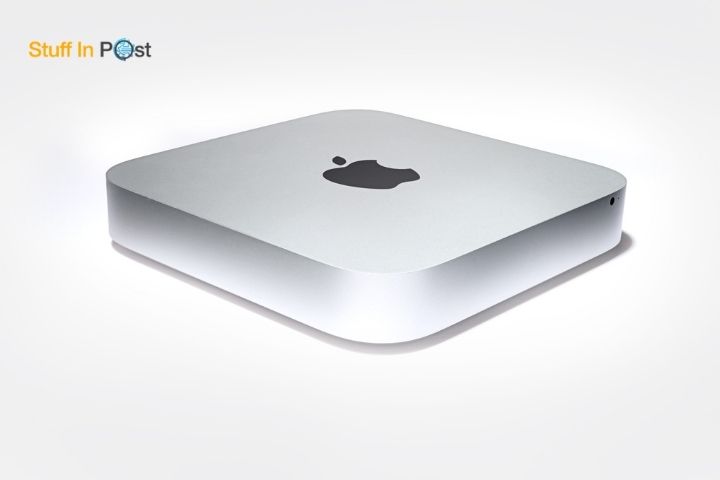Mac Mini 2020 Review With M1: There Is A Tiger In The Engine

Here it is finally. After witnessing the presentation of the new generation of MacBook Air, MacBook Pro 13 ″ and Mac Mini, they were looking forward to getting their hands on one of the new Mac models and the Mini in particular. The writer has had all generations of Mac Mini, from the very old Power PC versions, then through the various generations with Intel CPUs, including the model presented in 2018, the latter a “faithful” companion and only apparently “Mini”, configurable in various ways and able to perfectly perform the most disparate tasks. Having had all the Mini models available so far, we were looking forward to being able to test the latest addition as well. Here are characteristics, peculiarities, impressions and curiosities.
Packaging
The Mac Mini 2020 arrives inside a cardboard box no different from the previous one. Inside there is only the actual computer and the power cable (Italian / Euro plug). The Mini, as you probably know, is perfect for those who already have a monitor, keyboard and mouse: just attach these accessories and the computer is ready. You can take advantage of any USB-C, Thunderbolt, HDMI or other monitor using adapters (which must be purchased separately). Keyboard and mouse are not included; you can buy accessories or any Bluetooth or USB mouse and keyboard.
The Mac Mini 2020 arrives in a box very similar to that of the previous model. Mouse and keyboard are NOT included: any USB / Bluetooth mouse and USB / Bluetooth keyboard can be used. In the photo the new Mini together with the Magic Mouse, the extended Magic Keyboard and the Magic Trackpad.
Dimensions, Ports, Connections
Taken out of the box, the Mini measures 3.6cm (height) x 19.7cm (width) x 19.7cm (depth). The weight is 1.2kg. On the back, we find the power connector, the Gigabit Ethernet port, two Thunderbolt / USB 4 ports, the HDMI 2.0 port, two USB-A ports (up to 5 Gbps), the 3.5 mm headphone jack.
In addition to Gigabit Ethernet 10/100 / 1000BASE ‑ T, Wi-Fi 6 802.11ax connectivity (compatible with IEEE 802.11a / b / g / n / ac) and Bluetooth 5.0 wireless technology are supported. The speaker is integrated (a tiny speaker that offers the minimum wage) and luckily you can connect headphones or external speakers using the 3.5mm jack.
Two Thunderbolt / USB 4 ports allow you to connect Displayport monitors, support Thunderbolt 3 peripherals (up to 40 Gbps), USB 3.1 Gen 2 (up to 10 Gbps), Thunderbolt 2 peripherals, HDMI, DVI and VGA via adapters (sold separately ).
The Mini supports up to two monitors simultaneously: a monitor with resolution up to 6K @ 60Hz connected via Thunderbolt and a monitor with resolution up to 4K at 60Hz connected via HDMI 2.0. Native DisplayPort output via USB ‑ C works as Thunderbolt 2, DVI and VGA output (adapters required). The HDMI monitor output supports a monitor with resolution up to 4K at 60Hz; you can take advantage of any DVI outputs with an HDMI to DVI adapter.
The old Mini 2018 was able to support up to three displays (two with resolution up to 4096 × 2304 at 60Hz connected via Thunderbolt and the third via HDMI 2), while the new one stops at two displays but with resolution up to 6K ( at 60Hz).
When ordering it is possible to configure the Mini in various ways but the “heart” -chip M1 always remains the same. It starts from € 819.00 for the basic configuration with 8GB of unified memory (a single pool of broadband and low latency memory that allows apps to share data between the CPU, GPU and Neural Engine with the maximum efficiency) and the only possible variation for the RAM memory is the choice of 16GB. The Mac mini 2020 memory is not accessible by the user: if you think that more may be needed in the future, you must ask for the expansion at the time of purchase.
The storage offered as a base is a 256GB SSD but you can choose up to 2TB of storage (256GB SSD, or 512GB, or 1TB or 2TB).
Mac mini old and new and, in the background, the MacBook Air.
First Ignition
At the first start we combined a keyboard and a mouse, chose the system language and the other customary settings (iCloud, Filevault, WiFI password, etc.). The Mini obviously comes with the new macOS Big Sur as standard, an operating system indistinguishable from that for machines with Intel CPUs. What is immediately striking is the impressive speed with which it is possible to launch any standard application, thanks to the new architecture and also the new standard SSDs.
Try With Non-Optimized Applications
Applications compiled to work natively with the M1 chip are lightning-fast and start instantly. Various software houses have already released or are about to release optimized or “universal” applications, capable of running both on Macs with M1 CPUs and on Macs with Intel CPUs. Applications for Macs with Intel CPUs that have not yet been optimized or made universal can still be run thanks to a technology integrated into the operating system called “ Rosetta 2 “. All applications are supported, with the exception of particular software that takes advantage of intrinsic display technologies of Intel processors.
The first launch of non-optimized apps is slower but from the second launch onwards there is no longer any slowness (this is normal since Rosetta 2 has to “translate” the Intel instructions. The first non-optimized software we installed was Office 2019 for Mac When the Microsoft package was installed, the operating system asked if we wanted to install Rosetta; after a few seconds Rosetta was activated (it is nothing visible: it is a “transparent” technology that runs in the background, called up if necessary) allowing the installation of the package in a transparent way, taking a little longer than the time normally taken to complete this type of installation (due to the need to translate various utilities run by the installer with Rosetta).
Example of the message that appears at the first start of software created for Mac with Intel CPU
The first non-optimized software we tried to launch after installing Office 2019 was Word. The first run took about 20 seconds; at the second start, it started in about 4 seconds. Once the application is started, there are no differences in speed compared to what we were used to on the machine with Intel CPU, even when loading documents with hundreds of pages, complex documents with various images and links. Same with PowerPoint and Excel: slower first start; from the second start on, faster start and use without any problems. Same thing with applications of various types: we tried to run Illustrator, Photoshop, InDesign and dozens and dozens of other software not yet optimized but all fully functional on the new Mac with M1 CPU. The software works very well, without batting an eye, in some cases even giving the impression of responding faster.
The Optimized Applications
The speed is noticeable (and how!) With optimized applications.Apple already has its own ready: those of the iWork suite, iMovie, Garageband but also Final Cut Pro X and Logic Pro. Working with Final Cut Pro is a pleasure and the Mini does not bat an eyelid to manage movies even in 4K 60 fps HDR Dolby Vision, allowing you to edit and render with speeds that perhaps only those who use a latest-generation Mac Pro are used to. The fluidity is impressive and dwarfs even a 5K iMac with Intel i5 with 2GB external video card and 32GB of RAM. With video editing you can work with extreme fluidity: the Mini seems to “digest” the 4K 60fps files as if nothing had happened.
Single-Core, Multi-core And Application Benchmarks
Cinebench
We tested various benchmarking tools on the new Mini. The first one we started is Cinebench R23, a reference tool that allows you to take into account real uses in software for 3D modelling, animation, and rendering. The score obtained in the multi-core tests is 7786, higher than what can be obtained on a computer with Intel Xeon X5650 and slightly lower than what can be obtained with an Intel Xexon E5-2697 v2; in single-core tests, the score is 1520, higher than the Intel Core i7-1165G7 # 15W and similar to the Intel Core i7-1165G7 @ 28W.
The performance compared to the Mac Mini i3 3.6Ghz quad-core is practically double, making the previous processor used on the base model of mini pale. Using the old version of Cinebench, not optimized for M1 CPUs (compiled only for Intel processors) we got a score of 2108 in multi-core tests and 408 in single-core tests, once again superior performance to the Mac Mini with Intel CPU at 3.6Ghz with 44% faster speed in multi-core tests and 8% in single-core tests.
Geekbench
We performed the second test with Geekbench, the Primate Labs cross-platform benchmark that allows us to evaluate the performance of the CPUs by providing two results: one for workloads performed on a single core and the other for those performed using all the cores of calculation available. The Geekbench score was 1723 in single-core tests, and 7561 in multi-core tests. As a comparison with the Mac mini 2018 – in the 3.6Ghz quad-core i3 variant we achieved a score of 960 in single-core tests and 3353 in multi-core tests. In practice, the Mac Mini with the SOC M1 offers performance, once again equal to double.
Aja System Test For SSD
The speed of the SSD is excellent. We had the first confirmation with Aja System Test, a utility that allows you to check the data transfer values of the internal SSD in sequential mode. The results are more than excellent: 2121 MB / sec in writing and 2870 in reading. For comparison, with the 2018 Mac Mini, we had achieved: 2,866 MB / sec in writing and 3.043 MB / sec in reading. The Mac Mini 2020 is fast in opening apps and in the various tasks required: opening and closing windows, returning from sleep (instantaneous) and even in software such as Safari and Chrome you can see the difference in the scrolling of the pages.
IMovie Export
The export from iMovie of a movie of about 30 minutes with transitions and various titles took 2 minutes and 9 seconds on the Mac with M1 compared to almost 5 minutes on the old Mini with Intel. Also in Garageband, you can see the difference: exporting a 42-minute audio file in MP3 256k format took 10% less time than the same test performed on the Mini base 2018 with Intel CPU.
Also Read : 5 Things You Should Know About Tablets


